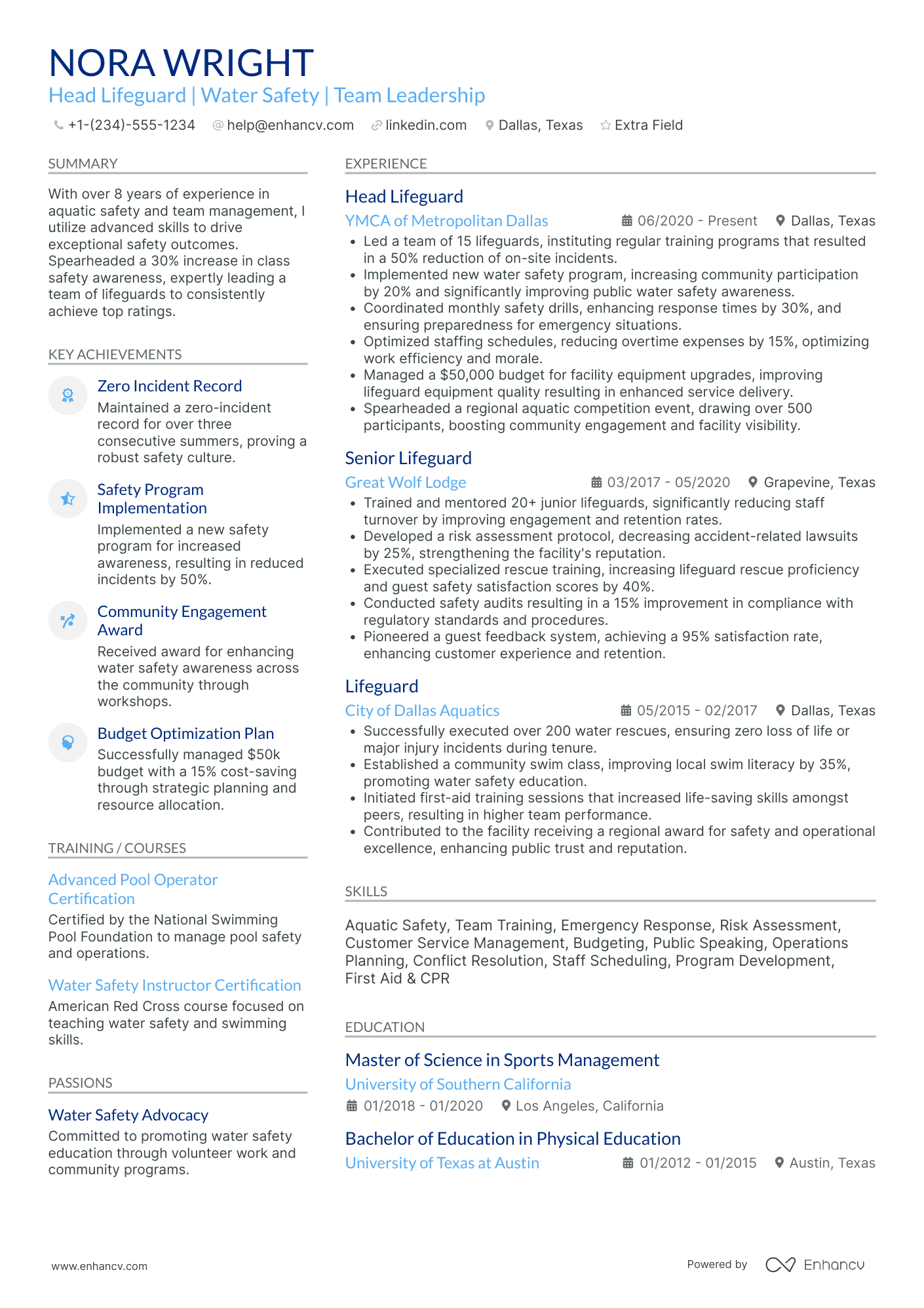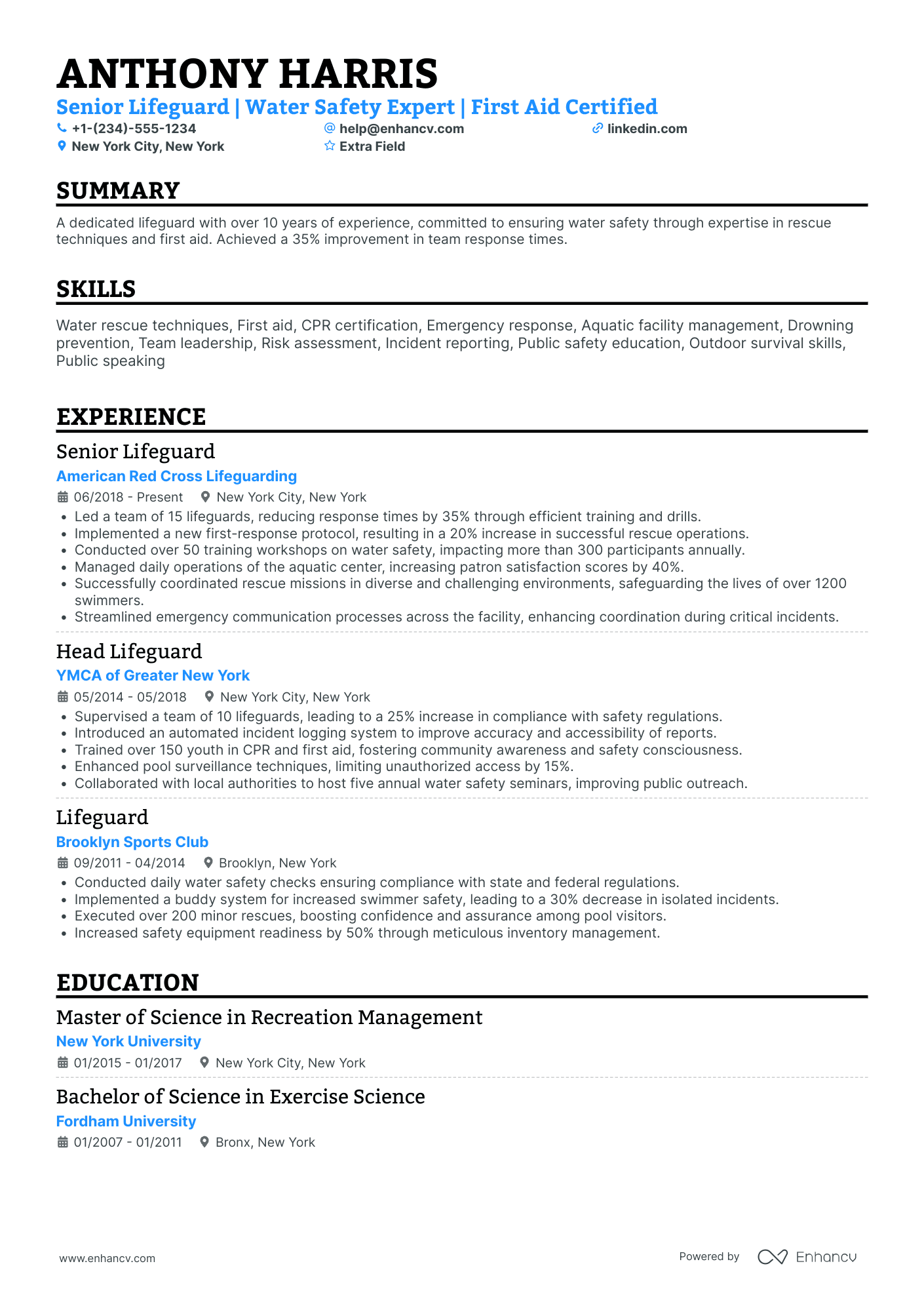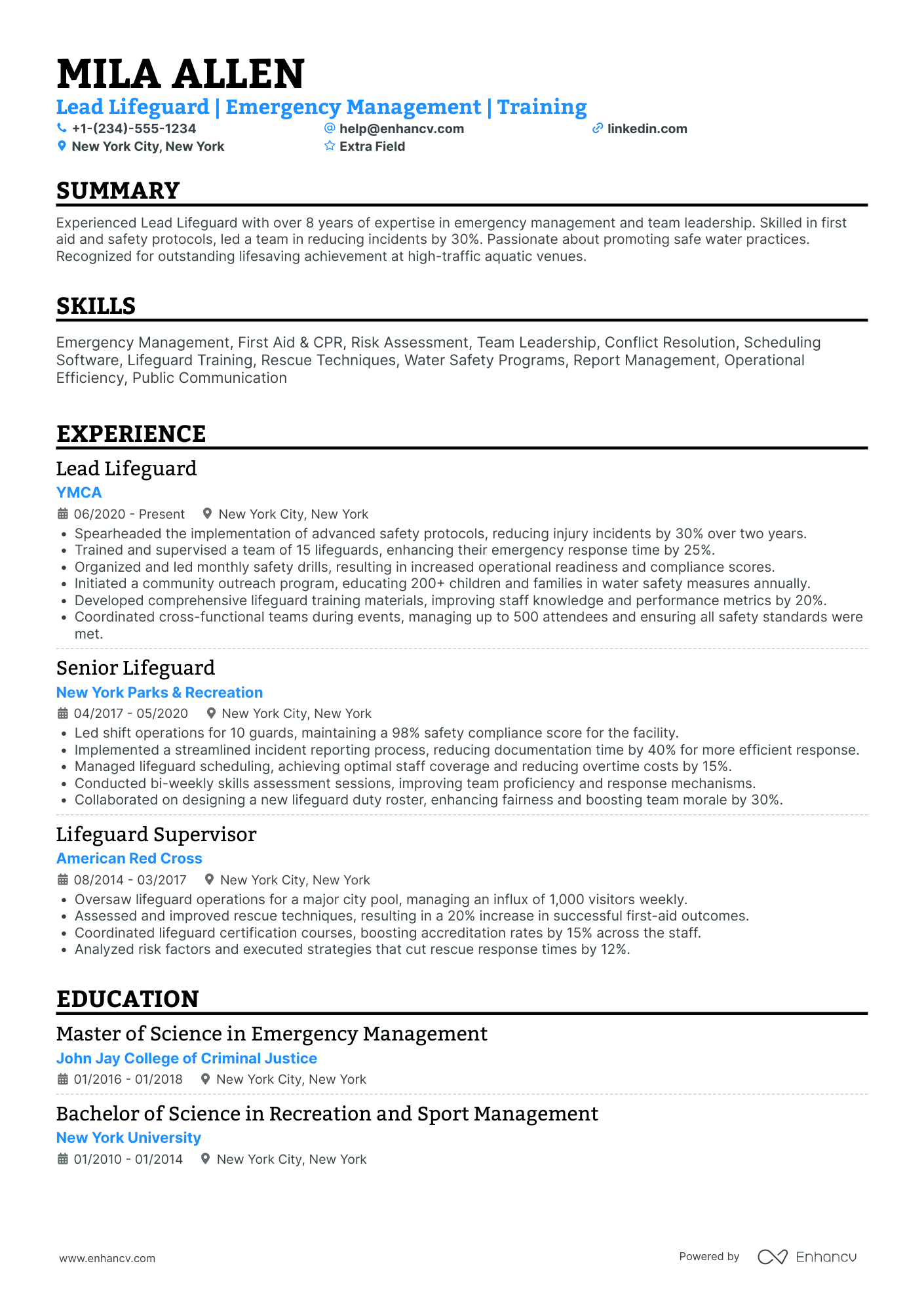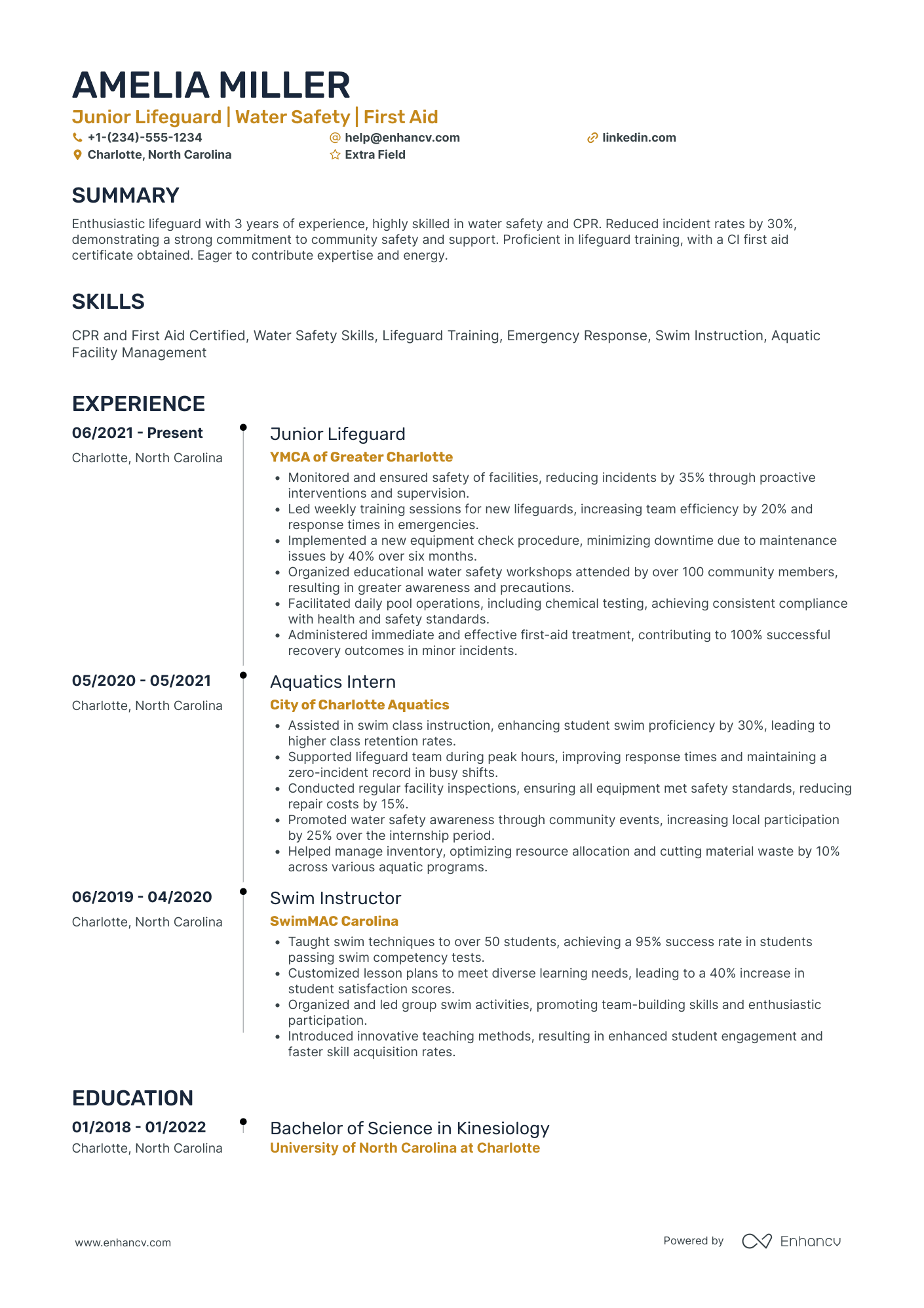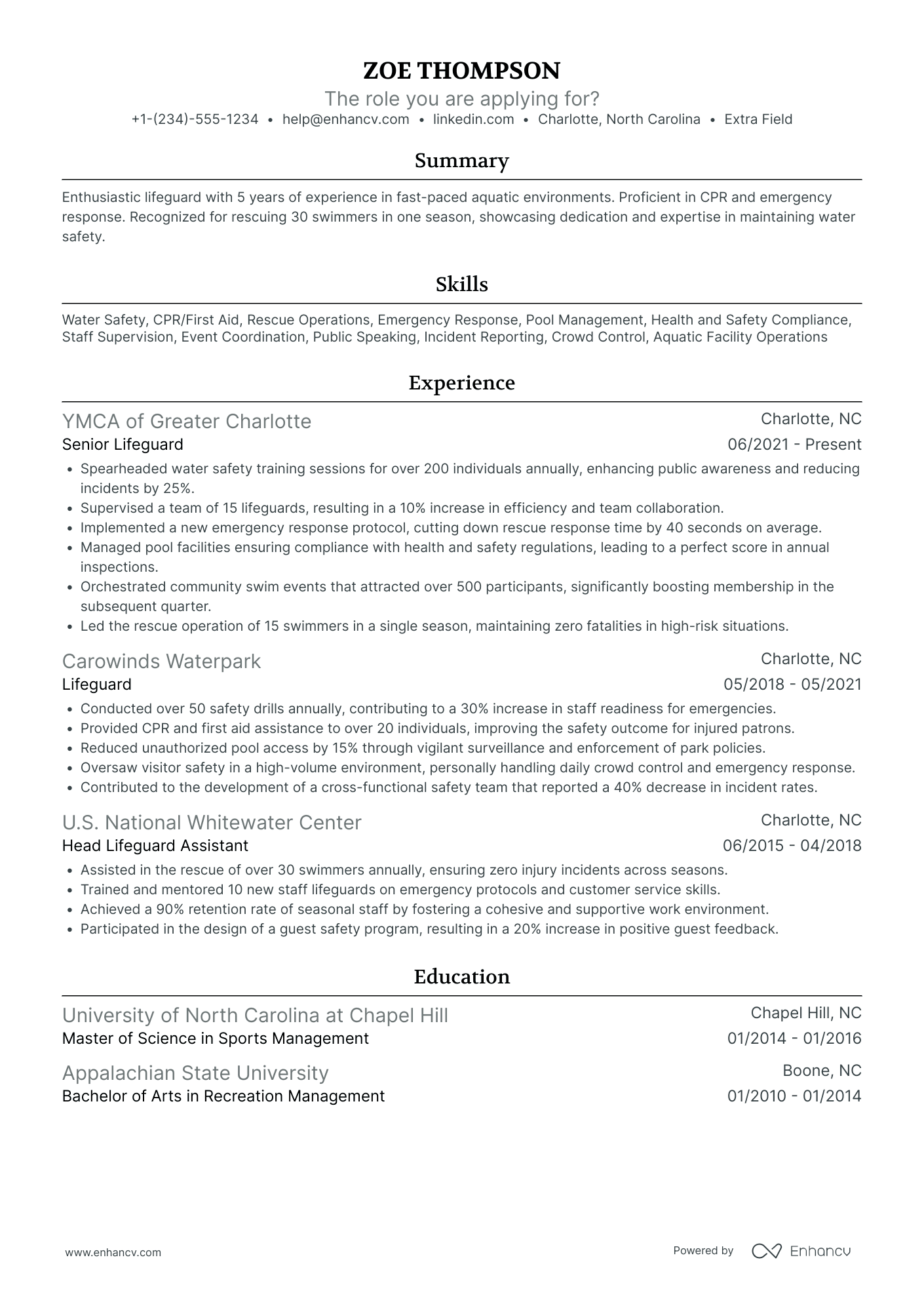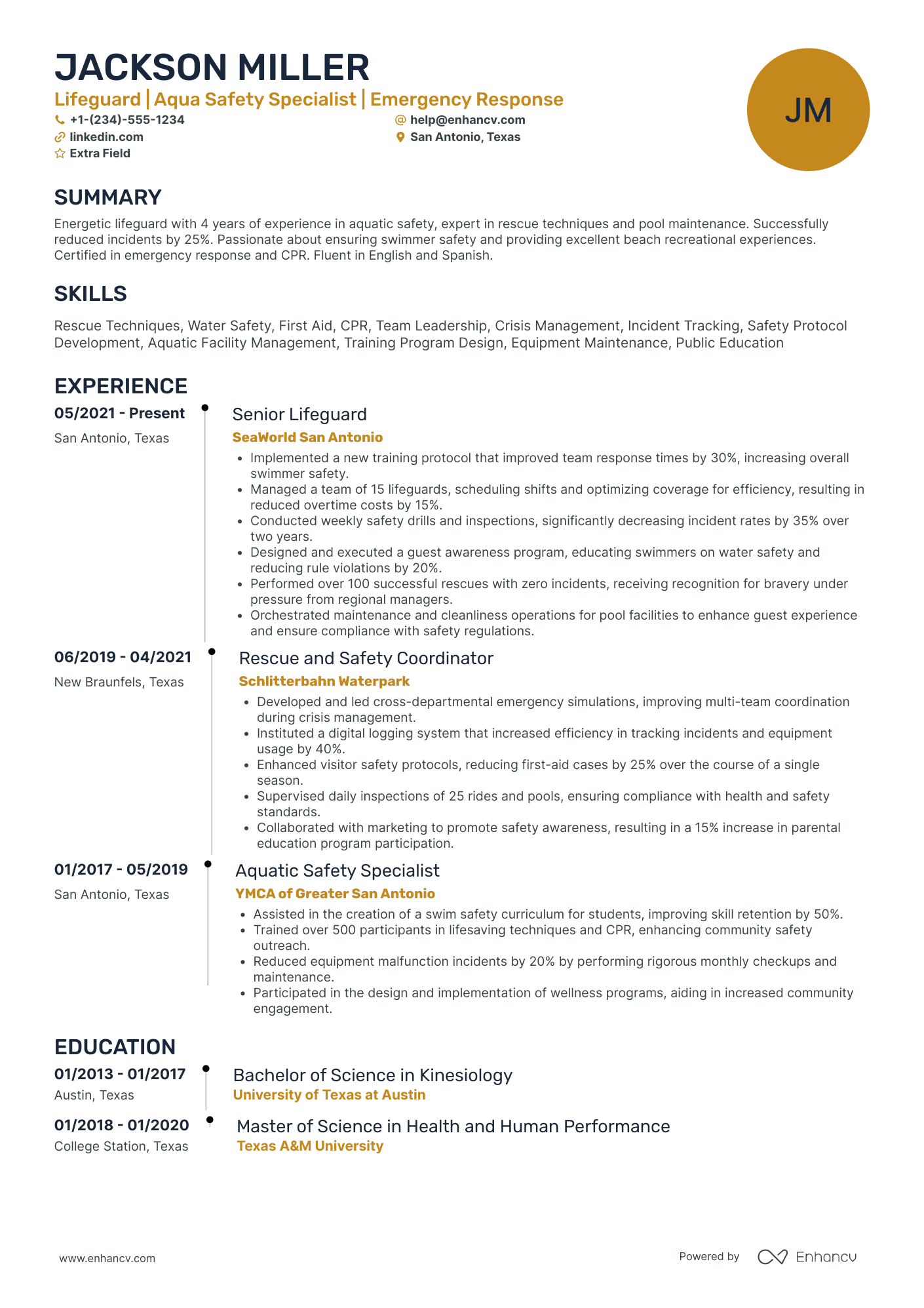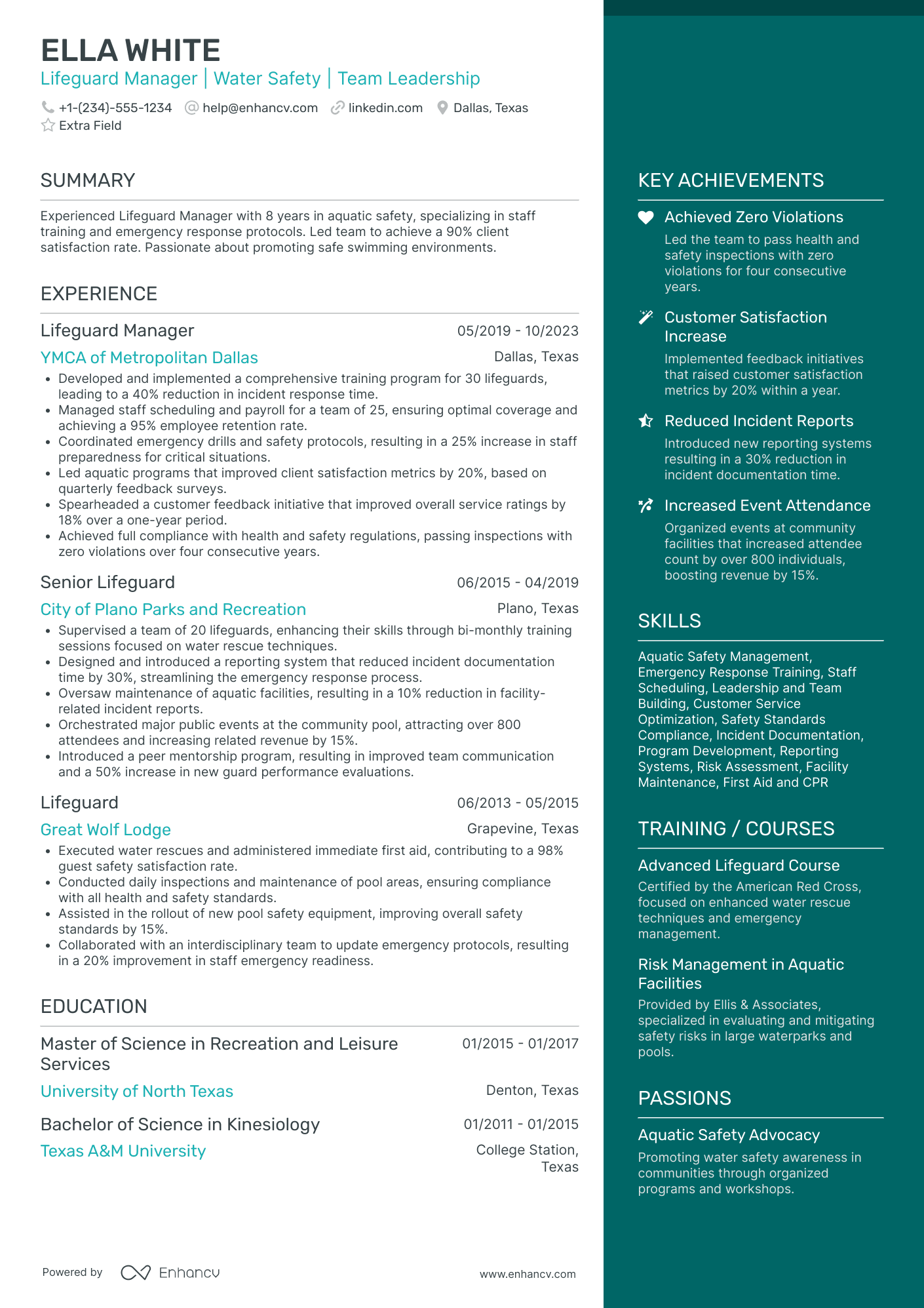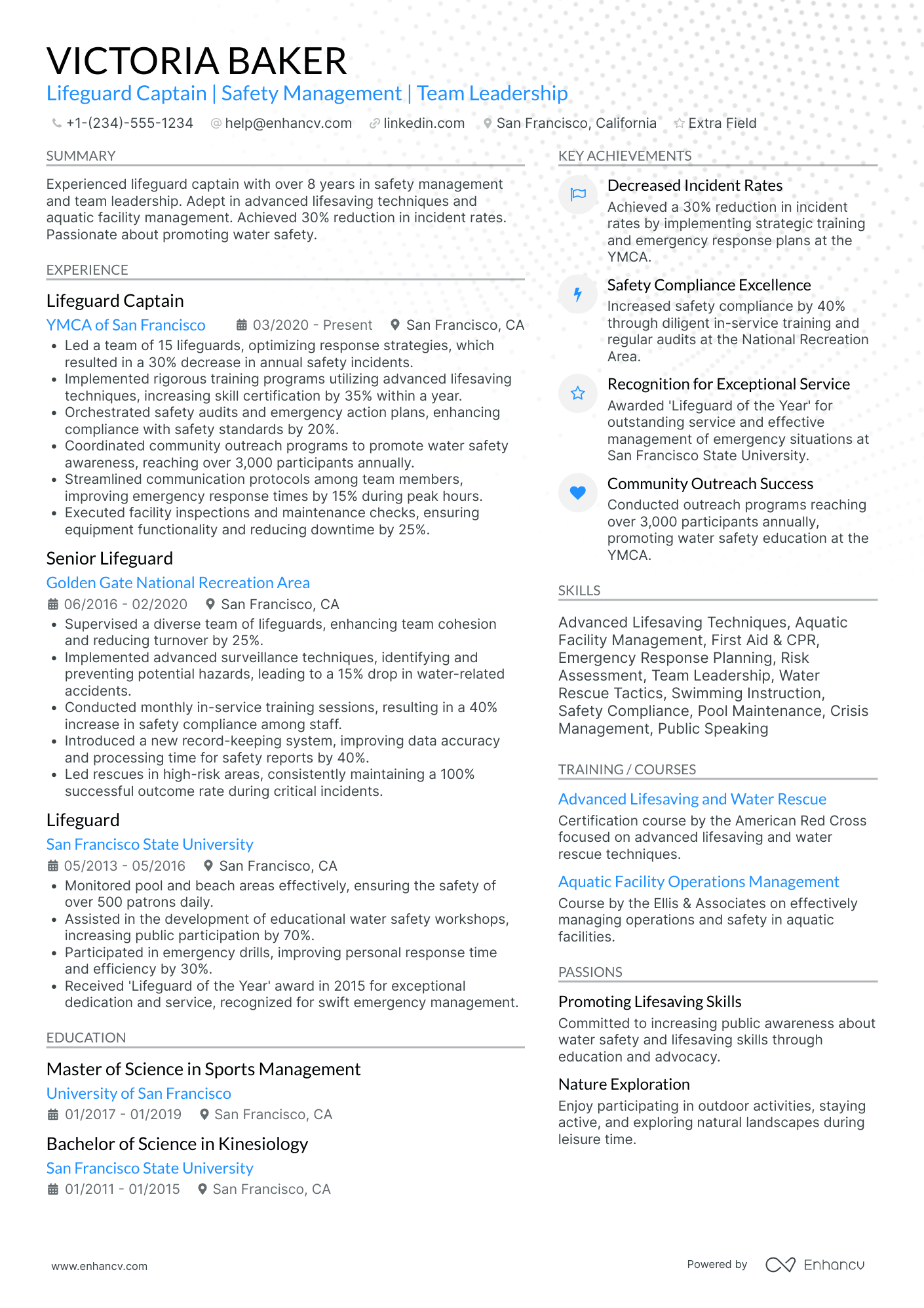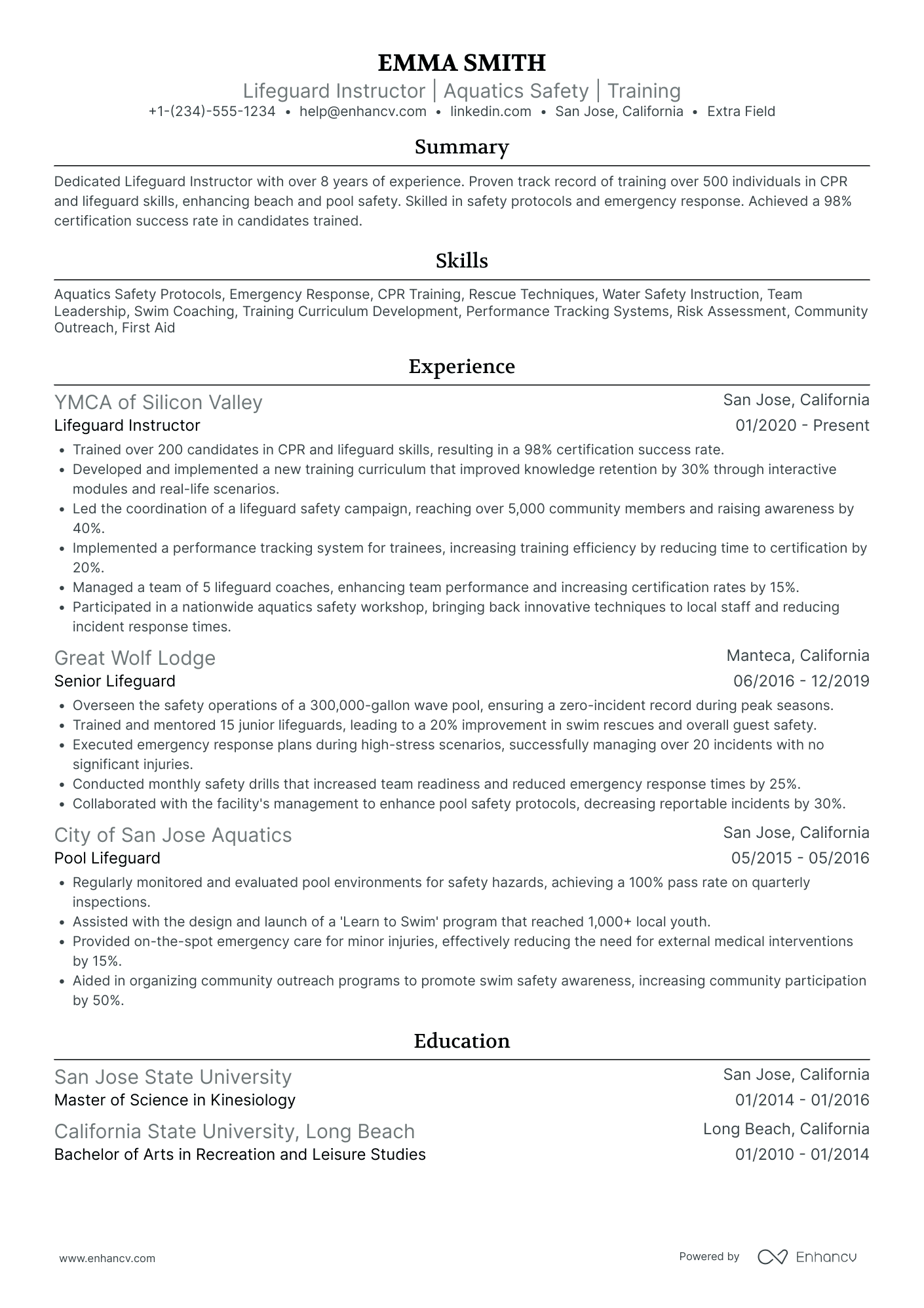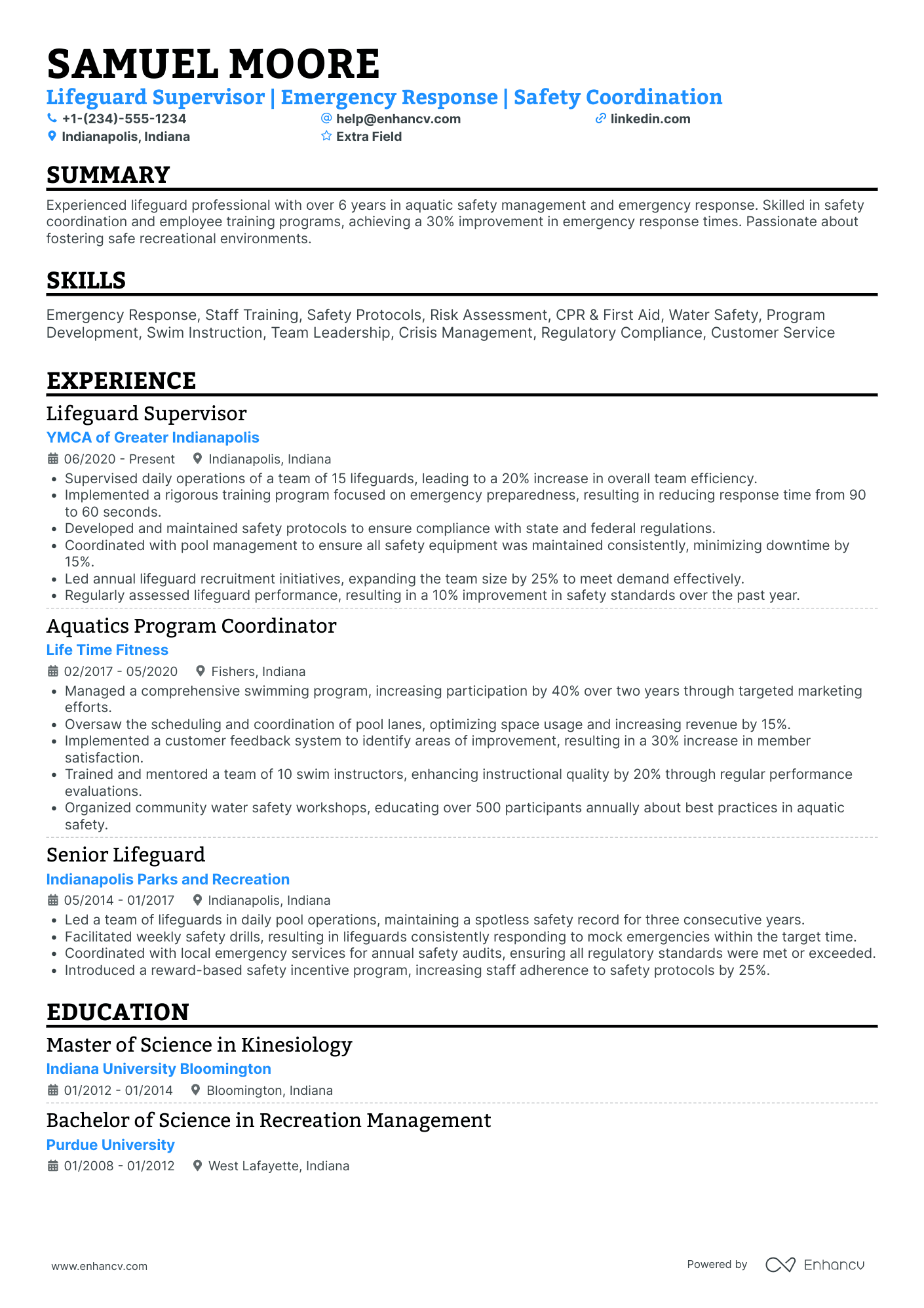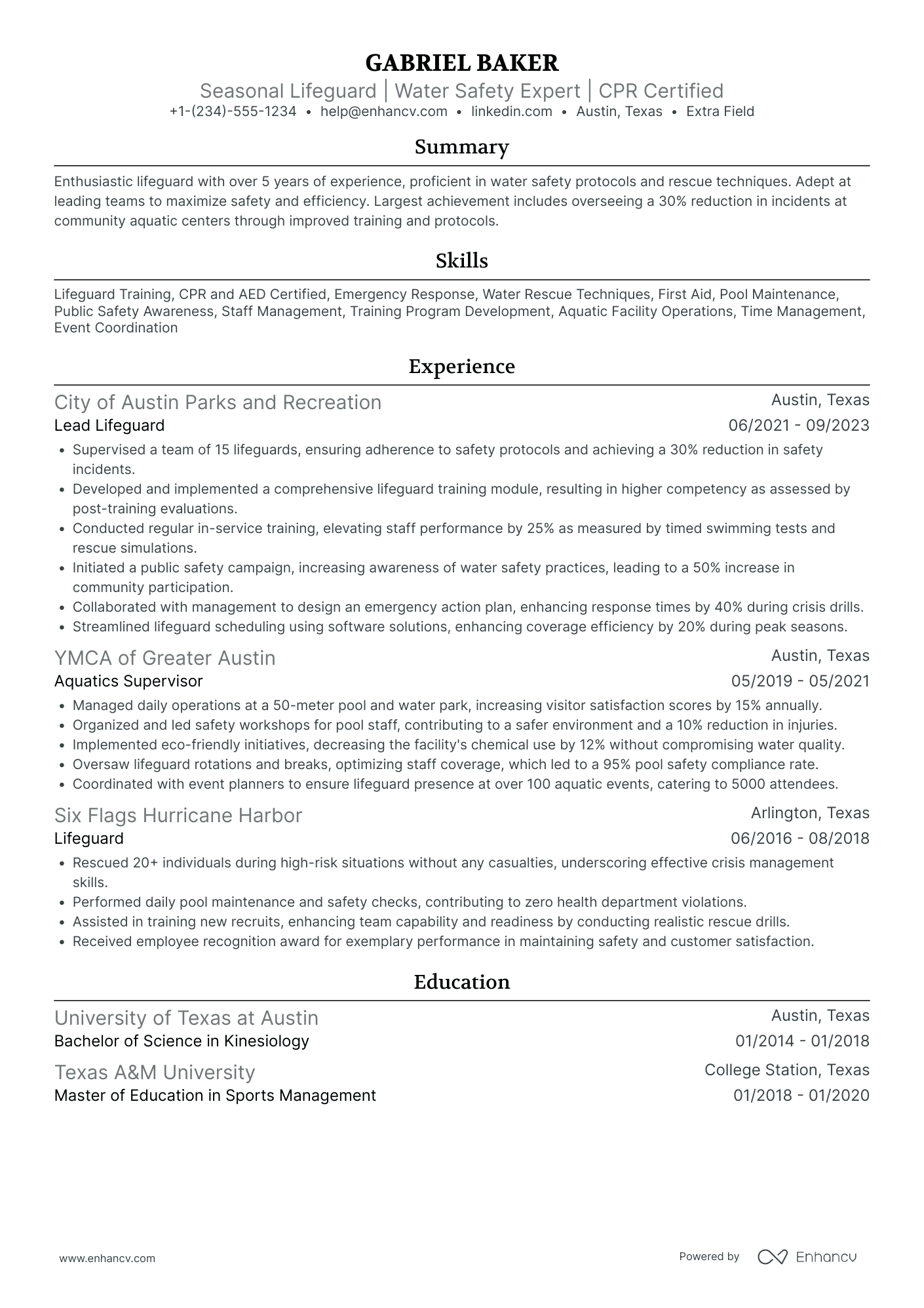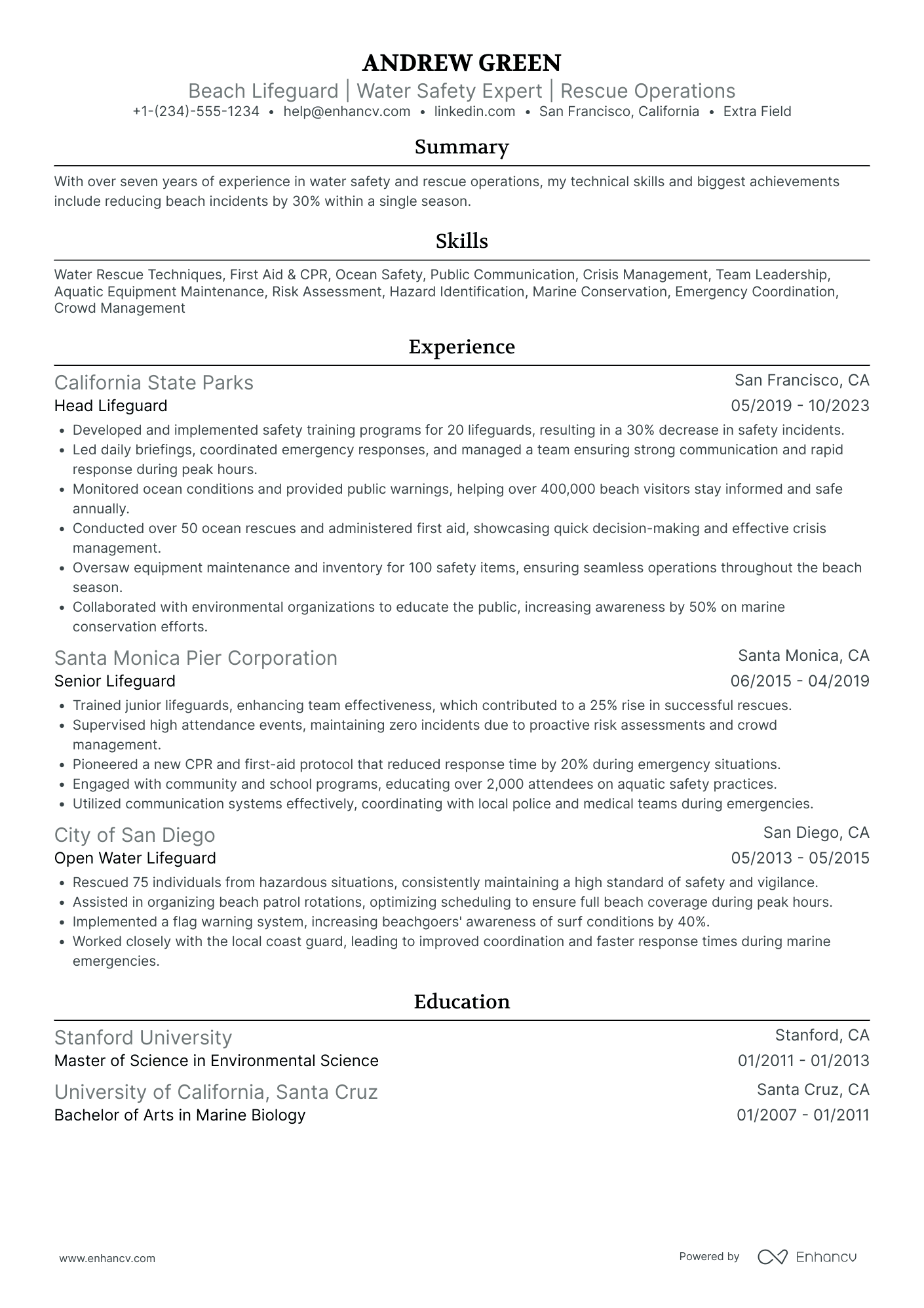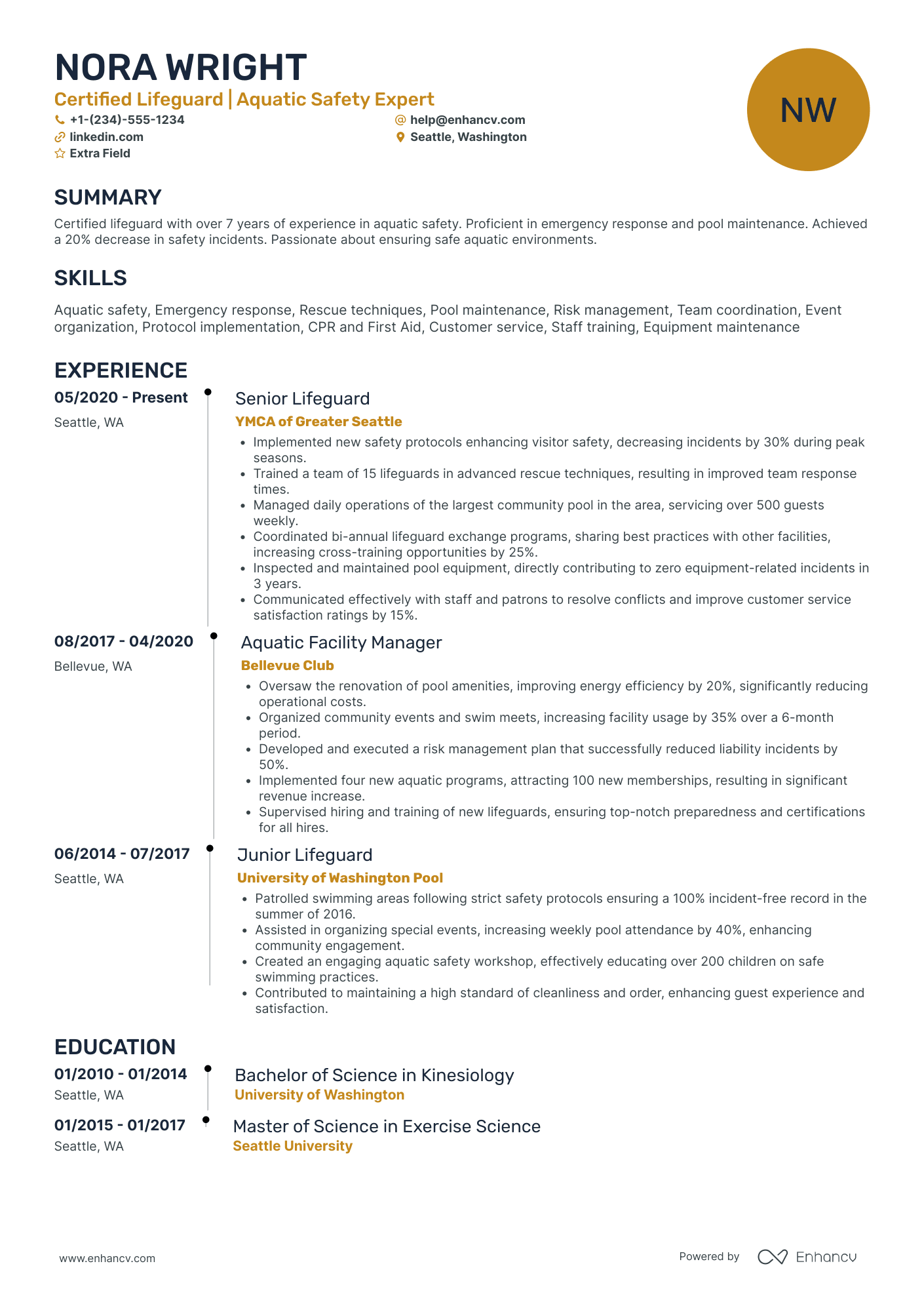As a lifeguard, you may encounter the specific resume challenge of effectively showcasing your vigilant observation skills and quick decision-making abilities. Our guide can assist by providing targeted advice on how to highlight these essential competencies with compelling action verbs and quantifiable achievements.
- Sample industry-leading examples to learn how to write your best resume yet.
- Improve the experience, education, and achievements section of your resume with insights from resume-writing professionals.
- Curate your technical expertise and personality to stand out amongst the pool of candidates.
- Succinctly focus on your unique skill set all through your lifeguard resume.
If the lifeguard resume isn't the right one for you, take a look at other related guides we have:
Tips and tricks for your lifeguard resume format
Before you start writing your resume, you must first consider its look-and-feel - or resume format . Your professional presentation hence should:
- Follow the reverse-chronological resume format , which incroporates the simple logic of listing your latest experience items first. The reverse-chronological format is the perfect choice for candidates who have plenty of relevant (and recent) experience.
- State your intention from the get-go with a clear and concise headline - making it easy for recruiters to allocate your contact details, check out your portfolio, or discover your latest job title.
- Be precise and simple - your resume should be no more than two pages long, representing your experience and skills that are applicable to the lifeguard job.
- Ensure your layout is intact by submitting it as a PDF. Thus, your resume sections would stay in place, even when assessed by the Applicant Tracker System (ATS).
Customize your resume for the market – a Canadian format, for example, might vary in structure.
Upload & Check Your Resume
Drop your resume here or choose a file. PDF & DOCX only. Max 2MB file size.
PRO TIP
List your educational qualifications and certifications in reverse chronological order.
Traditional sections, appreciated by recruiters, for your lifeguard resume:
- Clear and concise header with relevant links and contact details
- Summary or objective with precise snapshot of our career highlights and why you're a suitable candidate for the lifeguard role
- Experience that goes into the nuts and bolts of your professional qualifications and success
- Skills section(-s) for more in-depth talent-alignment between job keywords and your own profile
- Education and certifications sections to further show your commitment for growth in the specific niche
What recruiters want to see on your resume:
- Certifications in lifeguarding, CPR, first aid, and AED from recognized organizations (e.g., Red Cross, YMCA)
- Proven swim skills and physical fitness for performing water rescues
- Experience in monitoring pool or beach areas with vigilance to prevent accidents
- Ability to enforce safety regulations and manage a diverse group of swimmers
- Knowledge of emergency response procedures and first responder skills
The lifeguard resume experience section: a roadmap to your expertise
The resume experience section provides you with an opportunity to tell your professional narrative.
Recruiters, reading between the lines of your resume, use the experience section to better understand your unique skill set, accomplishments, and what unique value you bring about.
Discover five quick steps on how to write your experience section:
- Curate only relevant experience items to the role and include the company, description, and dates; all followed by up to six bullets per experience item;
- Each experience item should feature tangible results of your actions - if you can include a number or percent, this will further highlight your aptitude;
- If you've received any managerial or customer feedback, use short excerpts of it as further social proof of your technical or people skills;
- Make sure you're using the appropriate verb tense when listing your responsibilities;
- Within the description for each role, you could summarize your most noteworthy and relevant achievements.
Now, take note of how a real-world lifeguard professional received opportunities at industry leaders with these resume experience sections:
- Supervised a busy municipal pool, ensuring the safety of up to 250 swimmers per day by enforcing strict swimming guidelines and providing immediate assistance during emergency situations.
- Developed and implemented comprehensive lifeguard training program, leading to a 50% reduction in minor incidents and improved response times for critical events.
- Collaborated with local schools to conduct water safety workshops, reaching over 500 students and significantly increasing community awareness regarding drowning prevention.
- Monitored oceanfront activities at a high-traffic beach, averaging 1000 visitors daily, while coordinating with beach patrol to ensure visitor compliance with safety regulations.
- Conducted daily water quality tests and reported findings to the agency resulting in timely public health advisories and maintenance of beach cleanliness standards.
- Contributed to the design of a new beach signage system, which improved the clarity of safety instructions and contributed to a 30% decline in swim-zone violations.
- Perform vigilant surveillance of a luxury resort's aquatic facilities including multiple pools and private beach areas, catering to an elite clientele.
- Managed a team of 15 lifeguards, overseeing scheduling and continuous training, which improved team competency and guest satisfaction ratings by 25%.
- Initiated and led a successful initiative to upgrade rescue equipment, enhancing rescue operation efficiency and fortifying the resort's commitment to guest safety.
- Provided critical lifeguarding services at an indoor water park, adept at handling diverse aquatic attractions ranging from wave pools to water slides.
- Facilitated weekly in-service training sessions for a team of 20 lifeguards focused on emergency response scenarios, improving overall staff preparedness.
- Instrumental in coordinating a CPR/AED certification drive for lifeguard staff, leading to 100% certification achievement which enhanced our emergency response capabilities.
- Operated as a key member of the aquatic safety team at a state park lake, often managing guest safety across a span of over 2 miles of park shoreline.
- Assisted in the implementation of a new GPS-based distress signal system for quicker response to emergencies, reducing potential incident response time by an average of 40%.
- Organized a 'Swim Safe' campaign that educated over 300 campers on safe swimming practices, promoting a safer swimming environment throughout the park area.
- Monitored patron safety and performed rescues at a community center swimming pool, adeptly handling diverse age groups from toddlers to seniors.
- Played a pivotal role in revising the emergency response protocol, leading to a more efficient collaboration between lifeguards and emergency medical services.
- Launched a swim lesson program resulting in increased swim proficiency for over 200 participants and a 10% increase in community center aquatic program revenue.
- Served as a first responder at a large water theme park, handling crowd management and accident prevention for attractions hosting up to 5,000 guests daily.
- Introduced an innovative system of hand signals and communication to improve rapid response among lifeguard teams positioned throughout the park.
- Participated in the overhaul of the park’s risk management audit process, contributing to a mark of excellence from the National Water Safety Council.
- Oversaw junior lifeguards and conducted rigorous, real-world training scenarios for local youth programs at a popular community beach, enhancing the skills of 40 participants annually.
- Engaged in emergency planning and execution, demonstrating an exceptional ability to maintain composure and leadership during high-pressure situations.
- Actively participated in liaison with local marine conservationists to protect native wildlife while executing daily lifeguard duties, ensuring a safe and environmentally responsible beachfront.
The following content includes information from "O*NET OnLine" by the U.S. Department of Labor, Employment and Training Administration (USDOL/ETA). Used under the CC BY 4.0 license. The data represents the top responsibilities present on the task lists for lifeguard professionals.
Top Responsibilities for Lifeguard:
- Patrol or monitor recreational areas, such as trails, slopes, or swimming areas, on foot, in vehicles, or from towers.
- Rescue distressed persons, using rescue techniques and equipment.
- Contact emergency medical personnel in case of serious injury.
- Examine injured persons and administer first aid or cardiopulmonary resuscitation, if necessary, using training and medical supplies and equipment.
- Warn recreational participants of inclement weather, unsafe areas, or illegal conduct.
- Maintain quality of pool water by testing chemical levels.
- Complete and maintain records of weather and beach conditions, emergency medical treatments performed, and other relevant incident information.
- Instruct participants in skiing, swimming, or other recreational activities and provide safety precaution information.
- Inspect recreational equipment, such as rope tows, T-bars, J-bars, or chair lifts, for safety hazards and damage or wear.
- Inspect recreational facilities for cleanliness.
Quantifying impact on your resume
- Monitored safety of up to 100 swimmers on a daily basis, enforcing pool rules and regulations to ensure a secure environment.
- Conducted 50+ proactive interventions per week to prevent potential accidents and maintain aquatic safety standards.
- Trained and certified in Advanced Life Support (ALS), increasing the capacity to respond to critical incidents quickly and effectively.
- Performed 20+ weekly maintenance checks on rescue equipment and facility amenities to guarantee operational readiness.
- Successfully reduced the number of safety incidents by 30% year-over-year through vigilant supervision and public education on water risks.
- Administered emergency first aid and CPR to 15 individuals over the course of a summer, ensuring swift and efficient on-site medical response.
- Facilitated swimming skills improvement for 200+ pool visitors by providing corrective feedback and swimming tips during lifeguard shifts.
- Developed and executed a water safety workshop for the local community, educating 80 participants about drowning prevention and swimming best practices.
Action verbs for your lifeguard resume
Four quick steps for candidates with no resume experience
Those with less or no relevant experience could also make a good impression on recruiters by:
- Taking the time to actually understand what matters most to the role and featuring this within key sections of their resume
- Investing resume space into defining what makes them a valuable candidate with transferrable skills and personality
- Using the resume objective to showcase their personal vision for growth within the company
- Heavily featuring their technical alignment with relevant certifications, education, and skills.
Remember that your resume is about aligning your profile to that of the ideal candidate.
The more prominently you can demonstrate how you answer job requirements, the more likely you'd be called in for an interview.
Recommended reads:
PRO TIP
If the certificate you've obtained is especially vital for the industry or company, include it as part of your name within the resume headline.
The right balance between hard skills and soft skills for your lifeguard resume
Wondering what the perfect lifeguard resume looks like? The candidate's profile meets job requirements by balancing both hard skills and soft skills across their resume.
- Hard skills are all the technologies you're apt at using . Prove you have the right technical background by listing key industry hardware/software in your lifeguard resume skills section and noteworthy certifications.
- Soft skills are both your personal, mindset, communication, analytical, and problem-solving talents . Use your lifeguard resume achievements section to show how you've used a particular soft skill to reach a tangible outcome.
When writing about your unique skill set, always make sure to refer back to the job advert to see what are the key requirements. This ensures you've tailored your resume so that it matches closer to what the ideal candidate profile is.
Top skills for your lifeguard resume:
CPR Certification
First Aid Certification
Lifesaving Techniques
Swimming Proficiency
Rescue Equipment Operation
Automated External Defibrillator (AED) Use
Water Safety Knowledge
Surveillance Techniques
Emergency Response Planning
Health and Safety Regulations
Communication
Teamwork
Decision Making
Problem Solving
Attention to Detail
Customer Service
Leadership
Adaptability
Stress Management
Empathy
Next, you will find information on the top technologies for lifeguard professonals from "O*NET OnLine" by the U.S. Department of Labor, Employment and Training Administration (USDOL/ETA). Used under the CC BY 4.0 license.
Top technologies for Lifeguard’s resume:
- Microsoft Excel
- GroupMe
- Microsoft Outlook
PRO TIP
List all your relevant higher education degrees within your resume in reverse chronological order (starting with the latest). There are cases when your PhD in a particular field could help you stand apart from other candidates.
Discover the perfect certification and education to list on your lifeguard resume
Value the insights your resume education section offers. It can shed light on various proficiencies and experiences tailored for the job.
- Add only college or university degrees, stating the institution and duration.
- If you're nearing the end of your degree, note your graduation date.
- Weigh the pros and cons of including unrelated degrees - it might not be your best choice with so little space on your resume.
- Talk about your educational achievements if they amplify your relevant experience.
There are so many certificates you can list on your resume.
Just which ones should make the cut?
- List your prominent higher education degree in a separate box, alongside the name of the institute you've obtained it from and your graduation dates
- Curate only relevant certificates that support your expertise, hard skills, and soft skills
- Certificates that are more niche (and rare) within the industry could be listed closer to the top. Also, this space could be dedicated to more recent certifications you've attained
- Add a description to your certificates or education, only if you deem this could further enhance your chances of showcasing your unique skill set
When listing your certificates, remember that it isn't a case of "the more, the merrier", but rather "the more applicable they are to the industry, the better".
Recruiters have hinted that these are some of the most in-demand certificates for lifeguard roles across the industry:
The top 5 certifications for your lifeguard resume:
- Certified Pool Operator (CPO) - National Swimming Pool Foundation (NSPF)
- Professional Rescuer CPR - American Red Cross (ARC)
- Lifeguard Training (LGT) - American Red Cross (ARC)
- Advanced Lifesaving Certificate (ALC) - Royal Life Saving Society (RLSS)
- Emergency Medical Response (EMR) - American Red Cross (ARC)
The content below includes information from "O*NET OnLine" by the U.S. Department of Labor, Employment and Training Administration (USDOL/ETA). Used under the CC BY 4.0 license. The data represents the top associations for lifeguard professionals.
Top US associations for a Lifeguard professional
- American Avalanche Association
- American Heart Association
- American Red Cross
- National Ski Patrol
- NAUI
PRO TIP
If you happen to have plenty of certificates, select the ones that are most applicable and sought-after across the industry. Organize them by relevance to the role you're applying for.
Recommended reads:
The lifeguard resume summary or objective: integrating keywords, achievements, and more
Deciding whether to include a resume summary or an objective in your lifeguard resume is crucial. Both serve as key introductory elements at the top of your resume, encapsulating your profile in up to five sentences and incorporating relevant keywords from the job advert.
Here are the key differences between the two:
- The resume summary focuses on aligning your achievements and experience with the job requirements. It provides recruiters with a snapshot of your expertise, helping you stand out as an ideal candidate for the role.
- The resume objective, on the other hand, centers on your career goals and aspirations, detailing how the role aligns with your career progression. It's particularly suitable for candidates with less professional experience or those new to the job market.
Below are examples demonstrating best practices in utilizing the resume summary and/or objective to make a strong first impression with your lifeguard resume.
Resume summaries for a lifeguard job
- Seasoned lifeguard with over 7 years of vigilant service at dynamic beach resorts, adept at swift water rescue techniques and advanced first aid. Recipient of the Lifesaving Excellence Award for a record number of successful rescues in 2021, demonstrating an unwavering commitment to ensuring swimmer safety and maintaining a secure aquatic environment.
- Prior high school swim coach with 3 years of experience transitioning into lifeguarding, bringing a depth of knowledge in stroke techniques and swimmer supervision. Skilled in fostering a safe pool atmosphere and committed to applying effective training methods for emergency preparedness and response.
- Former paramedic with a decade of emergency medical response experience embarking on a career as a lifeguard. Equipped with critical lifesaving skills, including CPR and AED certification, aiming to leverage robust incident management capabilities to ensure visitor safety at busy water parks.
- A vigilant professional with 5 years of experience ensuring patron safety at a prestigious country club's aquatic facilities. Proven expertise in monitoring pool activities, executing rescue missions, and enforcing pool rules, highlighted by a zero-incident record during intensive summer camps and special events.
- Aspiring to safeguard swimmers at a coastal resort, an enthusiastic individual brings a fresh perspective to water safety. Eager to undergo rigorous training in water rescue and first aid to meet the objective of preventing accidents and responding to emergencies with precision and care.
- Driven by a passion for aquatic sports and community service, a motivated beginner aims to excel as a lifeguard. Committed to learning cutting-edge water rescue techniques and dedicated to mastering life-saving protocols to contribute to the safety and enjoyment of all pool and beach-goers.
Average salary info by state in the US for lifeguard professionals
Local salary info for Lifeguard.” Source: My Next Move, National Center for O*NET Development. Accessed 10/15/2024
| State | Average Salary (in USD) |
|---|---|
| US National Average | $30,380 |
| California (CA) | $37,030 |
| Texas (TX) | $26,300 |
| Florida (FL) | $33,150 |
| New York (NY) | $35,430 |
| Pennsylvania (PA) | $28,290 |
| Illinois (IL) | $30,580 |
| Ohio (OH) | $24,320 |
| Georgia (GA) | $31,200 |
| North Carolina (NC) | $26,710 |
| Michigan (MI) | $28,260 |
More relevant sections for your lifeguard resume
Perhaps you feel that your current resume could make use of a few more details that could put your expertise and personality in the spotlight.
We recommend you add some of these sections for a memorable first impression on recruiters:
- Projects - you could also feature noteworthy ones you've done in your free time;
- Awards - showcasing the impact and recognition your work has across the industry;
- Volunteering - the social causes you care the most about and the soft skills they've helped you sustain and grow;
- Personality resume section - hobbies, interests, favorite quote/books, etc. could help recruiters gain an even better understanding of who you are.
Key takeaways
Writing your lifeguard resume can be a structured and simple experience, once you better understand the organization's requirements for the role you're applying to. To sum up, we'd like to remind you to:
- Always select which experiences, skills, and achievements to feature on your resume based on relevancy to the role;
- In your resume summary, ensure you've cherry-picked your top achievements and matched them with the job ad's skills;
- Submit your lifeguard resume as a one or two-page long document at the most, in a PDF format;
- Select industry leading certifications and list your higher education to highlight you have the basis for technical know-how;
- Quantify your people's skills through various resume sections (e.g. Strengths, Hobbies and interests, etc.) to show recruiters how your profile aligns with the organizational culture.
Lifeguard resume examples
By Experience
Head Lifeguard
Senior Lifeguard
Lead Lifeguard
Junior Lifeguard
Full-Time Lifeguard
Part-Time Lifeguard
By Role
